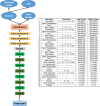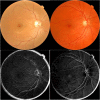Detection of smoking status from retinal images; a Convolutional Neural Network study
- PMID: 31073220
- PMCID: PMC6509122
- DOI: 10.1038/s41598-019-43670-0
Detection of smoking status from retinal images; a Convolutional Neural Network study
Abstract
Cardiovascular diseases are directly linked to smoking habits, which has both physiological and anatomical effects on the systemic and retinal circulations, and these changes can be detected with fundus photographs. Here, we aimed to 1- design a Convolutional Neural Network (CNN), using retinal photographs, to differentiate between smokers and non-smokers; and 2- use the attention maps to better understand the physiological changes that occur in the retina in smokers. 165,104 retinal images were obtained from a diabetes screening programme, labelled with self-reported "smoking" or "non-smoking" status. The images were pre-processed in one of two ways, either "contrast-enhanced" or "skeletonized". Experiments were run on an Intel Xeon Gold 6128 CPU @ 3.40 GHz with 16 GB of RAM memory and a NVIDIA GeForce TiTan V VOLTA 12 GB, for 20 epochs. The dataset was split 80/20 for training and testing sets, respectively. The overall validation outcomes for the contrast-enhanced model were accuracy 88.88%, specificity 93.87%. In contrast, the outcomes of the skeletonized model were accuracy 63.63%, specificity 65.60%. The "attention maps" that were generated of the contrast-enhanced model highlighted the retinal vasculature, perivascular region and the fovea most prominently. We trained a customized CNN to accurately determine smoking status. The retinal vasculature, the perivascular region and the fovea appear to be important predictive features in the determination of smoking status. Despite a high degree of accuracy, the sensitivity of our CNN was low. Further research is required to establish whether the frequency, duration, and dosage (quantity) of smoking would improve the sensitivity of the CNN.
Conflict of interest statement
The authors declare no competing interests.
Figures




References
-
- Organisation, W. H. The Top 10 Causes of Death, http://www.who.int/news-room/fact-sheets/detail/the-top-10-causes-of-death (2017).
-
- Saine, P. J. & Tyler, M. E. Ophthalmic photography: retinal photography, angiography, and electronic imaging. Vol. 132 (Butterworth-Heinemann Boston, 2002).
Publication types
MeSH terms
LinkOut - more resources
Full Text Sources
Other Literature Sources

